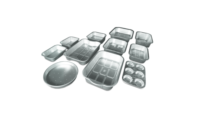Market Trends
The Transformation of Food Service Packaging
Digital technology makes its way into the food service experience.








The food service industry is in the midst of a major transformation. Digital technology is increasingly interwoven into the food service experience. A whopping 45% of quick service restaurants (QSRs) now provide a pick-up in store feature on their mobile apps.1 Kiosks are becoming a more common option for in-store ordering. McDonald’s recently announced it plans to install self-service ordering kiosks in all of its U.S. stores by 2020.2 These advancements offer consumers greater convenience and enable restaurants to repurpose or reduce labor at a time when labor shortages and rising labor rates have become a greater concern.
Digital technology has also led to the rise of third-party delivery companies like UberEats, DoorDash and GrubHub. These companies have helped drive an increase in delivery sales of 55% year-over-year in the U.S. this past year.3 Delivery has become an expectation for consumers and is now a big business, with Technomic estimating that consumers spent $10.2 billion on third-party delivery in 2018.4 The rapid rise in delivery has created new demands on takeout food packaging. Simply holding food for a short duration without leaking is no longer sufficient — packaging must do more.
The third-party delivery phenomenon creates an opportunity to re-invent food service packaging. One of the most common concerns about delivery expressed by consumers is food tampering. And their concerns are well founded; a recent study showed that nearly 30% of delivery drivers admitted to stealing food.5 To address this concern, WestRock has launched a new line of tamper-evident paperboard takeout containers called Bio-Pak Protect. Bio-Pak Protect is designed with a tamper-evident tear-strip that provides reassurance to consumers that their food is safe and no French fries go missing in action. The company has also worked directly with chain operators of various sizes, developing paperboard packaging solutions that improve heat retention, grease and moisture resistance and durability.
Sustainability is a key consideration in packaging decision-making for food service operators. Sustainability has moved from a “nice to have” to a “need to have,” which is a recent phenomenon. Legislation is a driving factor for the increased interest in sustainable packaging, and many municipalities have banned different forms of single-use food service packaging in recent years. Food service packaging legislation is complex; continually evolving and staying current requires vigilance. Companies like WestRock follow these developments and can be a resource to food service operators that are finding it difficult to navigate the changing packaging landscape.
Consumers are also driving the spike in demand for sustainable packaging. Millennials now represent $200 billion in buying power, and 72% say they will spend more money on brands that demonstrate social and environmental stewardship.6 WestRock studies show that the number one way consumers learn about a company’s views on sustainability is from information on the product packaging (44%).7 The takeaway? The packaging that a company chooses can greatly influence how customers perceive their commitment to and concern for the environment.
Some of the most exciting new food service packaging WestRock has produced this year are a result of true collaboration and partnership with chain customers who brought us in early in their development timeline and openly shared their objectives and vision. Together, customized food service containers were created that improved the customer’s sustainability profile by displacing foam and plastic options, all while meeting performance requirements and enhancing branding. WestRock EnShield Natural Kraft is a 100% recyclable kraft paperboard that provides a high level of oil and grease resistance without the use of plastic coating or fluorochemicals. The company recently launched a new, custom package made from ENK with a large QSR chain in the U.S. successfully.
In addition to innovating to give customers the opportunity to replace plastic packaging with fiber-based packaging, WestRock is leveraging its recycling network in the U.S. to improve the acceptance of food service packaging in residential communities. WestRock now accepts food service packaging at two of its material recovery facilities (MRFs) and
at all of its 100% recycled paperboard mills, including items that have historically ended up in landfills, such as single-use cups, sandwich clamshells and takeout cartons.
The food service space is highly competitive and continually evolving. New store concepts are opening all of the time, technology is enabling improved convenience, and sustainability expectations are increasing. In order to maintain customers and build brand loyalty, operators must keep up with industry trends that meet or exceed consumer expectations. Packaging plays a critical role in customer satisfaction. It must first do the basic job for which it was hired — contain food and preserve its integrity. Packaging that fails in this way can quickly create dissatisfied customers. However, once these packaging performance fundamentals are addressed, packaging can help food service operators reinforce brand positioning and differentiate them in the marketplace. Something as simple as packaging materials can have a large impact on how consumers perceive a brand’s premium level, sustainability and food quality.
- PYMNTS.com 2018 — Half Of Quick Service Restaurants (QSRs) Offer In-Store Pickup For App Orders
- Forbes, 2018 —McDonald’s Says Goodbye Cashiers
- Technomic, 2018 — The State of Off-Premise
- CNBC, 2019 — Panera Partners with UberEats, DoorDash, GrubHub to Expand Delivery
- NPR, 2019 — 1 in 4 Food Delivery Drivers Admit to Eating Your Food
- Nielsen, 2015 — Green Generation: Millennials say sustainability is a shopping priority
- WestRock Packaging Sustainability Study, December 2018. Online survey n=2,403.
WestRock partners with its customers to provide differentiated paper and packaging solutions that help them win in the marketplace. The company’s team members support customers around the world from locations spanning North America, South America, Europe, Asia and Australia.
Learn more at westrock.com.
Looking for a reprint of this article?
From high-res PDFs to custom plaques, order your copy today!









